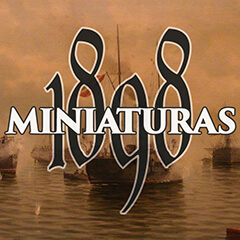The Cubans Who Would Be Kings. Wargaming 1898 Spanish-American War
Eduardo López
FUBAR Podcast

When 1898 Miniaturas guys asked me to adapt a set of wargame rules for the Wars in Cuba, from the very beginning I realized that the system should combine epic and playability, dynamism and historical flavour, richness in diversity of regular and irregular units, cavalry and infantry, and the ability to portray the different tactic situations that characterized this conflict. The chosen ruleset has the kiplinesque title of The Men Who Would Be Kings.
The Men Who Would Be Kings
The Men Who Would Be Kings, new ruleset from Osprey Games for colonial wars, by Daniel Mersey, author of other successful rulesets such as Lion Rampant or Dragon Rampant. If you know these other titles you already know what you are going to find: an easy to understand system with an appropriate period simulation for small units actions.
It comes with a points system to balance the scenarios, with 24 points being the standard, which would be equivalent to about 50 miniatures of regular infantrymen or a hundred tribal warriors, although it can be played with different point amounts. It models troops using adaptable archetypes, correctly represents the different types of terrain and equipment, and incorporates a nice system of traits for the officers, who will not only be ‘competent’ or ‘incompetent’, but have personal skills or defects, adding that special chrome that sets the difference between colonial wargaming and other periods.
And, as an original feature, it has rules for solo play or cooperative, with all players in the same side, allowing them to manage the enemy by following a series of patterns and tables, or leaving that task in the hands of the always ruthless referee. To avoid creating confusion between the original game and 1898’s adaptation, original game concepts and terminology are shown in italics.
The Cuban Wars, 1868-1898
The struggle for Cuban independence is not limited to the “Disaster of 98” (name given in Spain to the loss of the remnants of the Empire in 1898 after the war). There were three wars, of which the American intervention is only an episode, although the definitive one. Therefore, some of the options that we will offer below will belong to one of the following periods: the Great War (or Ten Years´ War, 1868-1878), the Little War (1879-80) and the Second War (the Spanish-American War, the war that, forgetting the previous ones, is usually known in Spain as the Cuban War, 1895-98).
The Mambi army
‘Mambí’ (plural, Mambises) is one of the names with which the Cuban rebels were known, and the one that has left the biggest mark on popular imaginary that alluded to a peasant or person of low extraction, it somehow reveals the Dominican origin of most of the leaders of the insurrection.

Troops
Infantry regulars
To represent the organized units of the rebellion, we will use the Irregular Infantry profile with the poorly armed option, with a base cost of 3 points. This option adequately represents the heterogeneous mix of firearms used by the rebels throughout the period.
Options:
- Veteran: Great War: there must be a poorly armed unit for every veteran unit used; Little War: no veteran units can be used; Second War: 1-2 veteran units can be used.
- Unenthusiastic: 0-1 units can be Unenthusiastic; Little War: 1 unit mandatory.
- Fieldcrat: any unit can choose this option.
- Well Armed: 0-1 units can be Well Armed. There must be a poorly armed unit for every Well Armed unit used.
- Sharpshooters: 0-1 units can be Sharpshooters, which also needs to have the well armed option.
Horse regulars
To represent mambí mounted troops we will use the tribal cavalry profile, which is the one that best fits the so-called ‘machete charge’ tactic.
Options:
- Veteran: any number of units can be veteran. If more than two cavalry units are used, one must be veteran to represent elite troops that served as bodyguards of rebel generals.
- Unenthusiastic: 0-1 unit per every two of better quality. Little War: 1 unit mandatory.
- Sharpshooters: 0-1 units can be Sharpshooters, save in the Little War.

Guajiros
This is the traditional name of the Cuban peasant. To represent these groups of inexperienced volunteers we will use the tribal infantry profile. We can have 0-2 units of Guajiros in the Great War (only until 1870); 1-3 units during Little War; And, during the Second War, 1-2 units until 1896; 0-1 units from then on.
Options:
- Unenthusiastic: any number of units.
- Fierce: 0-1 units. Little War: no unit can be fierce.
Artillery
Artillery was never a powerful weapon in the hands of the rebels. However, we could include up to 1 field gun, poorly drilled, in our mambí field force. To represent an oldie piece (as the famous”Trifulca”), or the Dudley-Simms dynamite cannon, we’ll use the jamming rule (see machine guns section).
Army rules
From the theater specific rules (36-39 pages), we’ll use the following:
- Limited ammunition.
Troops
Regular infantry
Under this denomination we group line infantry as well as ‘cazadores’ (light infantry) battalions, Marine infantry and Guardia Civil (paramilitary police). We will represent them with the regular infantry profile, although unenthusiastic and poor shots, at a cost of 4 points. The unenthusiastic option represents both raw units and those decimated by tropical fevers, with their reduction of effectiveness, as well as the fear that, in certain times, came from the feared machete charges of the rebels. Poor shots represents the reduced training of the ‘quintos’ (newly raised recruits), as well as the transition, almost without respite, from percussion caps to breech-loading guns (Remington) and then to the Mauser or bolt-action guns.
Options:
- Elite: represents Marine infantry, Guardia Civil or units very used to tropical climate, or with a larger ratio of veteran soldiers. 0-1 units between 1868-1873, 1-2 from then on.
- Sharpshooters: 0-1 until 1897, 0-3 from then on, as units equipped with Mauser rifle.

Infantry volunteers
Formed by Cuban residents, they mostly were a source of trouble and disturbance, and where the most intransigent grouped with the simple idea of autonomy for the island. They were used mainly as garrison units. We will use the irregular infantry profile, with unenthusiastic and poor shots options, at 2 points per unit. The unenthusiastic option reflects their lack of training and their lack of motivation to leave their towns and cities. The poor shots options represent both their lack of training and the use of obsolete weapons, better than the poorly armed option. 0-1 units between 1868 and 1870.
Options: none.
Infantry Guerrillas
True counter-insurgency units, made up of volunteers from various units, civilians from all backgrounds (including prisoners) and rebel deserters, they were very useful. Leading one of them, the Cazadores of Valmaseda, General Weyler won his first laurels. We can also include in this category those volunteers units of greater military value. We will use the irregular infantry profile.
Options:
- Veteran: any number of units.
- Fieldcrat: any number of units.
- Well Armed: 0-2 units
- Sharpshooters: 0-1 units can be Sharpshooters, which also needs to have the well armed option. Second War: 0-2 units, with same requirement as above.
- Mounted infantry: 0-1 unit, can´t be of lesser quality than any other guerrilla unit, if more than one is used.

Regular cavalry
Mainland Spain cavalry units, and mounted Tercios of the Guardia Civil. They are unenthusiastic, at 5 points per unit.
Options:
- Elite
- Lancers: only during the Great War.
Cavalry volunteers
Mounted equivalent of their homonymous on foot. They had some use in campaign, for their greater mobility, although the best served as the base for the units shown of the following epigraph. We use the irregular cavalry profile, unenthusiastic option, at 3 points per unit.
Options:
- Well armed
Mounted Guerrillas
The horseback equivalent of guerrilla infantry. Some of them were created from of volunteers units, or grouping rebel deserters with small detachments of Spanish mainland cavalry. Given their mobility and versatility, we can represent them as irregular cavalry.
Options:
- Veteran.
- Well armed: 0-1 units.
Artillery
Artillery, formed by mainland units, had an excellent performance, although usually using mountain or light guns, to allow for greater mobility of the columns. They perfectly fit with the description of crewed weapons profile, which we will represent as well drilled, field gun.
Army rules
The following theater specific rules (pages 36-39) are always used
- The climate.
- “When Private Widdle Faces the Burpas”
Scenarios
The scenarios contained in the ruleset that better represent warfare in Cuba are the following:
- Seek & Destroy: Mambises should be the attackers, with the famous ‘torch tactic’.
- To the last bullet: both sides can be attackers.
- Run to the Hills!: Mambises should be the defenders.
- Take the high road: Both sides can be attackers, although Spanish should attack more often as it fits better with the scenario.
- It’s awfully quiet out there… : Mambises should be the attackers.
- A sight of relief: Spanish should be the defenders.




